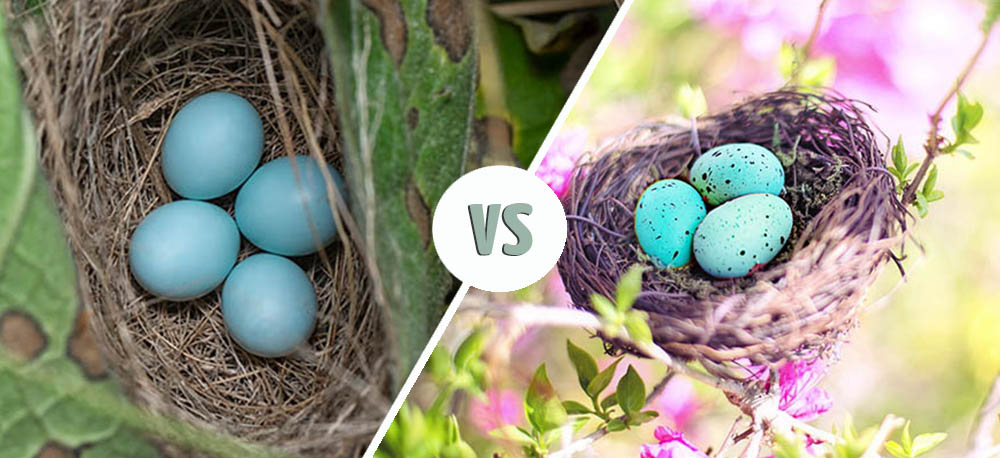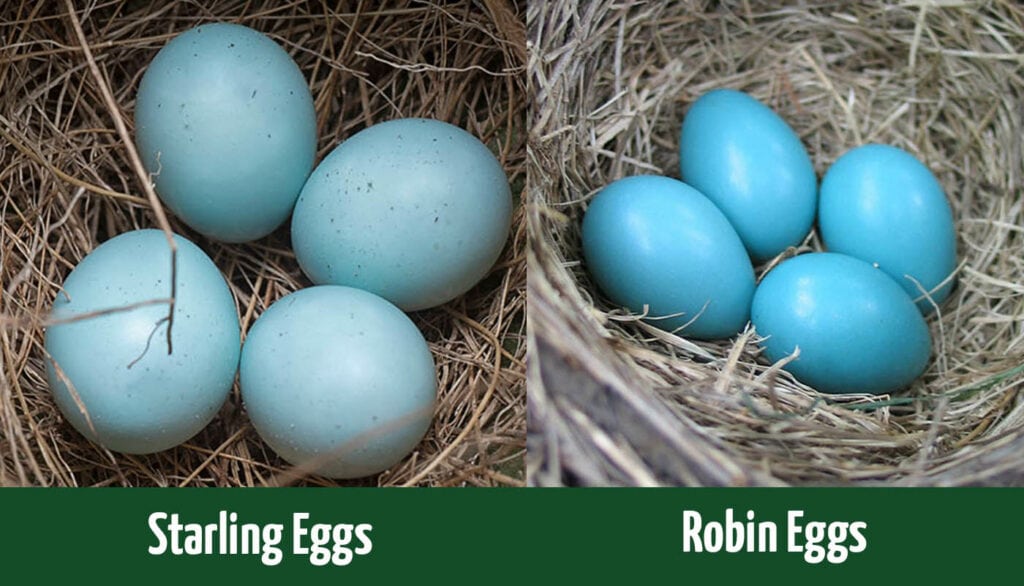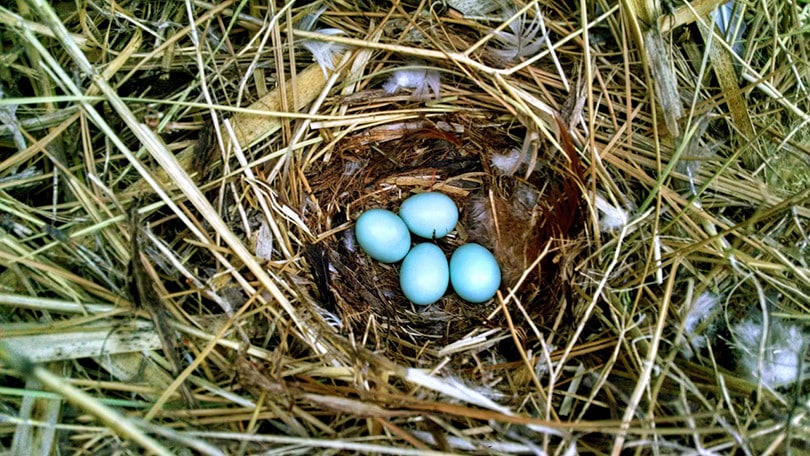Starling Eggs vs Robin Eggs: How to Tell the Difference
Last Updated on

All species of birds lay eggs, but some are more exceptional than others, making them stand out from the crowd. Starlings and Robins are two completely different birds, although both are widespread across the US.
Starlings are native to Asia and were brought to the USA in the 1890s. They are medium-sized birds, slightly smaller than Robins. These birds have some positive sides as they are social, and you can notice them in large flocks during winter. However, they are invasive and can take over other birds’ nests and even kill them.
Robins are relatively large birds, distinctive due to their orange bellies. These songbirds are friendly, and you can attract them to your backyard. They’re cheerful, and you can frequently notice them in parks and lawns, searching for food.
These birds are entirely different but share one similarity—their eggs are blue, which makes them special and visually appealing. Keep reading to learn more about their eggs and how to differentiate them.

Visual Differences

Starling eggs are a bit smaller than Robin eggs, and they have somewhat pointy ends, while Robin eggs are rounder. When it comes to color, Starling eggs have a slight gloss, and they are light bluish/greenish white, while Robin eggs are typically bold-blue, sky-blue, or blue-green.
At a Glance
- Origin: Asia
- Size: 7,5–9 inches
- Lifespan: Around 15 years
- Domesticated?: Yes
- Size:1 inches
- Incubation period: 12 days
- Origin: USA and Canada
- Size:9–11 inches
- Lifespan: 5–17 years
- Domesticated?: No
- Size:1–1.2 inches
- Incubation period: 12–14 days
Starling Overview
Nesting
Starlings are nest competitors with other birds, which is one of the reasons they’re considered invasive. When they nest, they don’t establish territory, so instead, they have loose colonies. They build their nests out of the grass, weeds, pine needles, and dried leaves, while they commonly add plastic, paper, or cloths, they find outside.
Unlike most birds, where the female is in charge of building the nest, Starling males start the nest while the female finishes it.

Egg Characteristics & Appearance
Starlings lay eggs in mid-April, typically in a batch between four and six eggs. All birds in the colony lay eggs within a few days, and the females are in charge of the incubation that lasts 12 days.
The eggs are slightly pointy, and they are around 1.1 inches long. They are pale greenish-white or bluish-white and glossy. On rare occasions, they can have small brown-reddish markings. They are darker and smaller than Robin eggs.
Young
The female broods the young while both parents provide food. For the first 12 days, they eat strictly insects and larvae, while their diet broadens afterward. They leave the nest about 3 weeks after hatching, although the parents keep feeding them for the next week or two until they become independent.

Robin Overview
Nesting
American Robins find their pairs during the breeding season. The females are in charge of building the nest while the males bring them twigs, branches, leaves, and other nesting materials. They also add mud as the main element of their nesting structure.
They nest throughout the US, and both parents are aggressive when it comes to protecting the nesting area.

Egg Characteristics & Appearance
Female American Robins lay one egg per day and do it for 3 to 4 days, meaning they get a total of three or four eggs. They raise multiple broads a year, especially in the southern areas of the US, and the eggs need around 2 weeks to hatch.
They are blue and about 1.2 inches long, typically without markings, although they sometimes have brownish spots.
Young
The females are the only ones in charge of the eggs until they hatch, and after they do, young American Robins tend to stay in the nest for around 13 days. Both parents bring food and defend the nest from predators. Baby Robins typically eat worms, insects, and berries.
What Are the Differences Between Starling Eggs & Robin Eggs?
When it comes to the differences between Starling eggs and Robin eggs, the most significant dissimilarities are the color, shape, and number of eggs you see in the nest.
Starling eggs are more pointy, while Robin eggs are rounded. Although both birds lay blue eggs, the color varies, and Starling eggs are typically paler, while Robin eggs have a rich color. Also, Starling eggs have a slight gloss, while Robin eggs are matte.
Starlings bear four to six eggs, while Robins bear three to four, which is another way to recognize the eggs you notice in a nest.

Conclusion
There’s no doubt that both Starling and Robin eggs are beautiful and intriguing. However, when it comes to preserving the eggs, it’s more important to help out a Robin female than a Starling female, as Starlings are non-native and invasive.
Featured Image Credit By: (L) Swee Ming, Shutterstock | (R) Jill Wellington, Pixabay
About the Author Visnja Radosavljevic
Visnja is a creative, adaptable content writer that covers various topics such as DIY, pets, home improvement, travel, gardening, and more. As a young mom and a college student, she didn’t have enough time to balance her personal and work life, so after multiple years of working a regular 9 to 5 job, she decided to pursue her passion and make a living out of it. She has been writing for a couple of years now, helping people to find valuable and interesting information online.
Related Articles:
Monocular vs Telescope: Differences Explained (With Pictures)
Holy Stone Drone Review of 2024 – Pros, Cons, and Verdict
Ultraviolet Light vs Black Light: What’s the Difference?
Light Waves vs. Sound Waves: The Key Differences
Infrared vs. Thermal Cameras: How Are They Different?
Far Infrared vs Near Infrared: What’s The Difference?
Mottled Duck vs. Mallard vs. Black Duck: What’s the Difference?
Shutter Speed vs Frame Rate: Pros, Cons, & Difference
